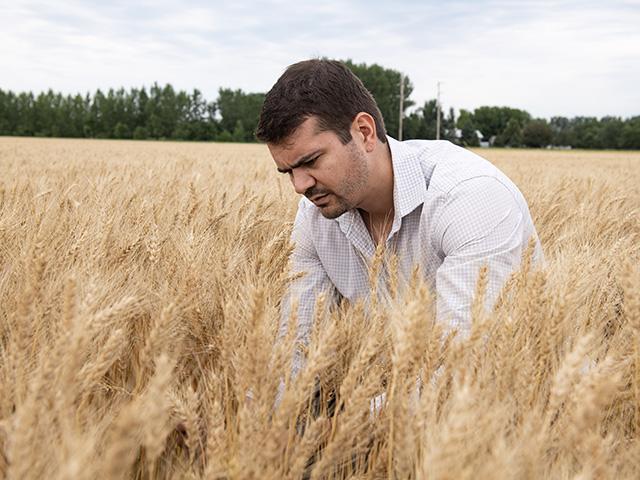Spring Wheat Tour Final Results
Spring Wheat Tour Final Average Yield Estimate: 47.4 BPA
FARGO, N.D. (DTN) -- The Wheat Quality Council's Spring Wheat and Durum Tour concluded Thursday, July 27, in Fargo, North Dakota. After three days of scouting fields across the state and some into neighboring Minnesota, the total weighted average yield for spring wheat was estimated at 47.4 bushels per acre (bpa), while durum finished at 43.9 bpa. Last year, the yield estimates for the tour were 49.1 bpa for spring wheat and 39.0 bpa for durum.
Day 3 of the tour commenced in Devils Lake. Scouts traveled along eight routes, assessing fields throughout northeast North Dakota and the western counties of Minnesota before reconvening in Fargo. On the day, 52 fields were scouted, 50 of which were spring wheat. The weighted average yield was 50.6 bpa, down from 53.1 bpa last year for the same leg of the tour.
Over the course of the three days of scouting, nearly 60 tour participants traveling in 14 groups assessed a total of 343 wheat fields, which was 39 more fields than in 2022. Of the total, 318 fields were spring wheat, 21 were durum and four were winter wheat.
"I don't know how this crop is going to end up -- three weeks is still a long time (to maturity) -- but I've really felt like we made a good effort to describe the crop as we saw it this week," said Dave Green, Wheat Quality Council executive vice president and tour organizer, who completed his 44th tour. "As we began the week, the comment was made that it looked like the earliest-planted wheat was in the worst shape, and it looked like the later-planted wheat was in better condition. As the week went on, I felt that was a good comment. That seemed to really describe what we were seeing.
"I thought the later-planted wheat looked good, the condition was good," he continued. "It's dry, but the crop wasn't stressed, and I thought it was doing really well filling kernels."
The tour's 47.4 bpa average for spring wheat is nearly identical to the 47.0 bpa yield estimate for North Dakota that the USDA National Agricultural Statistics Service (NASS) in its Crop Production Report released on July 12. Nationally, USDA estimated a yield of 45.2 bushels per harvest acre, down 1.0 bushel from last year.
For durum, the tour's estimated yield of 43.9 bpa was significantly higher than the 34.0 bpa average that USDA published for North Dakota in its July report. Overall, USDA forecast durum production to decrease 16% to 54.0 million bushels with a national average of 37.9 bushels per harvested acre, down 2.6 bushels from 2022.
P[L1] D[0x0] M[300x250] OOP[F] ADUNIT[] T[]
Green noted that this year's tour participants were particularly enthusiastic and eager to tackle the task at hand. They asked relevant questions that kept him and other tour leaders on their toes.
"I thought it was a great group," he said. "We had a nice blend of folks representing government, the grain industry, milling, baking and producers. When you get those kinds of combinations, it really works well.
"We're trying to do a good job so that we're able to look people in the eye, whether we were right or wrong," he added. "We publish our data, and it's relatively close to the government every year. So, I have no reason to think it won't be this year."
In its most recent weekly wheat update released July 25, the North Dakota Wheat Commission reported that despite the later start to planting, crop development had caught up or surpassed the five-year average -- the result of warm, dry conditions. Though moisture during the past week was almost non-existent, some areas did receive measurable rainfall thanks to pop-up showers. Overall, during the past month, precipitation has been below average across the entire state with amounts ranging from 10% to 60% below normal.
Yet despite less-than-ideal conditions, the wheat crop is showing its resiliency, the commission report stated. Producers said that while rainfall was needed, the crop was hanging tough. Many said they still expect a crop that yields close to average.
For the week ending July 23, the USDA-NASS Crop Progress and Condition Report rated the North Dakota spring wheat condition as 6% very poor, 12% poor, 28% fair, 51% good and 3% excellent.
The U.S. Drought Monitor map released July 27 showed roughly a 10% increase in areas of abnormally dry and moderate drought conditions in North Dakota as compared to the week prior. While about 35% of the state is still not experiencing drought, nearly 20% is experiencing moderate drought.
The next USDA Crop Production Report will be released Aug. 11, 2023.
For more on this year's Spring Wheat and Durum Tour, please read:
Day 1 results: https://www.dtnpf.com/…
Day 2 results: https://www.dtnpf.com/…
To see the results of past wheat tours organized by the Wheat Quality Council, go here: http://www.wheatqualitycouncil.org/….
Jason Jenkins can be reached at jason.jenkins@dtn.com
Follow him on Twitter @JasonJenkinsDTN
(c) Copyright 2023 DTN, LLC. All rights reserved.






